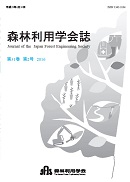
- |<
- <
- 1
- >
- >|
-
Masahiko Nakazawa, Tatsuya Sasaki, Chikashi Yoshida, Takumi Uemura, Hi ...2020Volume 35Issue 4 Article ID: 35.189
Published: October 31, 2020
Released on J-STAGE: November 01, 2020
JOURNAL FREE ACCESSThis study aimed to develop a low-cost broadleaved biomass supply system, for which a broadleaved forest was harvested with forestry vehicles on a flat land in the snowing season. We analyzed the productivity of the broadleaved forest and also estimated the amount of energy resources. Three different operation systems were applied. The current system mainly employs a chainsaw operated by manpower. Machine systems use a feller-buncher or a harvester for the felling and processing operations. Felling productivity of the current chainsaw system was found to be 3.8 m3h−1worker−1, that of the machine feller-buncher system was 2.8 m3h−1worker−1, and that of the machine harvester system was 3.0 m3h−1worker−1. The processing productivities were estimated to be 3.6 m3h−1worker−1 (current system), 2.8 m3h−1worker−1 (feller-buncher system), and 3.0 m3h−1worker−1 (harvester system). The entire labor productivities were measured to be 1.7 m3h−1worker−1, 1.9 m3h−1worker−1, and 2.1 m3h−1worker−1. Furthermore, the machine systems were good at harvesting broadleaved trees in the snowing season from a safety perspective owing to their limited working time on the field. The amount of unused energy resource is expected to reach 28% of the whole cut mass, which is equivalent to that of harvesting coniferous trees in an artificial forest.
View full abstractDownload PDF (780K) -
Ichiro Watanabe2020Volume 35Issue 4 Article ID: 35.197
Published: October 31, 2020
Released on J-STAGE: November 01, 2020
JOURNAL FREE ACCESSA novel silviculture machine has been developed based on an off-the-shelf ride-on style weeding machine (CG510 manufactured by Chikusui Canycom Co., Ltd.) but with the addition of a stump cutting function. We examined the cutting speed and weeding work cost of larch stump removal using this new silviculture machine. As a result, average-sized stumps in this test (31.0-cm diameter and 22.8-cm height) could be cut in about 85 s. The performance of weeding work, including stump cutting (larch stump density: 570/ha), was 0.062 ha/h. The weeding work efficiency on forest land not cleared of stumps was 20% lower than a shoulder-hanging type brush cutter, but weeding work on forested land after stump cutting was 0.212 ha/h or about 2.8 times that of a shoulder-hanging type brush cutter. Based on these results, we performed a trial calculation of weeding operation costs. For the novel machine to be cost-effective compared with standard weeding practices, the weeding operation with inclusive stump cutting requires an area of at least 50 ha or more per year; it further requires an operation area of an additional 25 ha or more per year after the stump cutting operation in order to be lower than the standard weeding operation cost.
View full abstractDownload PDF (1314K) -
Seishiro Taki, Masahiko Nakazawa, Masashi Saitou, Katsumasa Oono, Hide ...2020Volume 35Issue 4 Article ID: 35.203
Published: October 31, 2020
Released on J-STAGE: November 01, 2020
JOURNAL FREE ACCESSStructure from motion (SfM) requires multiple images taken from multiple viewpoints. For this reason, when shooting an image, it is necessary to stop after each shot and always pay attention to the overlap and sidelap rates. This study elucidates a simpler method for three-dimensional (3D) point cloud data conversion of work road images. A follow shot was performed while walking with a digital video camera, after which a 3D structure of the work road was made based on the video data. Therefore, a detailed 3D point cloud using an SfM processing software (Pix4Dmapper) was constructed using images (180) extracted from each captured frame of the video. At this time, all images could be automatically matched without selecting images according to their quality or manually setting key points. These results showed that follow shooting could be a simpler method for constructing 3D point cloud data of work roads. From these results, a simple survey was performed using a personal computer. Also, vertical and cross-sectional views were created, and the reproducibility of the point cloud data and the shooting method was clarified on the basis of the video.
View full abstractDownload PDF (8440K)
-
Genki Ito, Kazuhiro Yabe, Yuki Imatomi2020Volume 35Issue 4 Article ID: 35.209
Published: October 31, 2020
Released on J-STAGE: November 01, 2020
JOURNAL FREE ACCESS -
Yuta Inomata, Hirokazu Yamaguchi, Kengo Usui2020Volume 35Issue 4 Article ID: 35.215
Published: October 31, 2020
Released on J-STAGE: November 01, 2020
JOURNAL FREE ACCESS -
Chisa Nakata, Akemi Itaya2020Volume 35Issue 4 Article ID: 35.223
Published: October 31, 2020
Released on J-STAGE: November 01, 2020
JOURNAL FREE ACCESSTransportation distance and time are important factors for efficient timber transportation and driver management in forestry industries. A low-cost or free, and an intuitive and simple operation to estimate transportation distance and time would be useful for forestry industries. The purpose of this study was to build a system for estimation of transportation distance and time including the inside of forests using Google Maps routing system, taken between artificial forests and a woody biomass power plant as an example. Mie Prefecture, located in central Japan, was selected as our study site. As a result, the system was built to estimate the transportation distance and time including the inside of forests using the winding factor of forests roads. The transportation distances from forests to the biomass plant in the city of Tsu ranged from 15.54 to 173.30 km, and transportation time ranged from 0.54 to 5.86 h. The estimated harvestable area was smaller than the result calculated using the transportation distance and time that had been used in previous studies. Our system can estimate transportation distance and time in the forests based on actual road routes in Google Maps instead of radius circular range. Therefore, this system would contribute to efficient timber transportation and driver management.
View full abstractDownload PDF (574K)
- |<
- <
- 1
- >
- >|